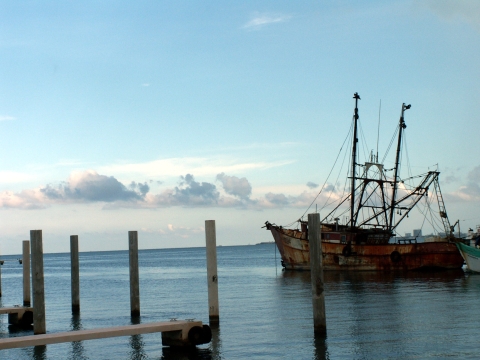Fishers use a variety of techniques and gear to pursue target fish and shellfish. “Commercial fishing” is defined in the Magnuson-Stevens Fishery Conservation and Management Act as “fishing in which the fish harvested, either in whole or in part, are intended to enter commerce or enter commerce through sale, barter, or trade.” Fisheries bycatch is the accidental hooking, entanglement, or other incidental take or capture of non-target species, including migratory birds, resulting from fishing activities.
Many seabirds have low reproductive rates, undergo long and strenuous migrations, face multiple threats over their large geographic ranges, and associate with fishing vessels while foraging, making their populations particularly vulnerable to mortality from fishing gear.
How do commercial fisheries impact migratory birds?
The primary way birds interact with commercial fisheries is direct bycatch by active fishing gear or fishing gear that has been lost, abandoned, or discarded in the environment. Interactions can also occur when baited hooks are easily accessible to birds, putting them at risk for being hooked or ensnared as they pursue the bait. Furthermore, fishing vessels provide food resources to birds by discarding fish waste and offal. Birds can also collide with fishing vessels, particularly in low visibility conditions.
What can I do to avoid and minimize impacts to birds?
Multiple measures can be employed to reduce bird bycatch from commercial fishing operations. Depending on the type of fishing operation and gear being used, multiple measures may need to be used simultaneously. Some basic measures include:
- Managing discards in a manner that reduces bird attraction to fishing gear or distracts birds from high-risk areas.
- Using mitigation measures appropriate for the fishery where potential for bird interactions is higher, such as avoiding areas where high numbers of birds are concentrated in active foraging areas or adjacent to breeding colonies during the nesting season.
- Releasing any live birds after removing as much fishing gear from the birds as is safely possible.
- Ensuring control and retention of gear using established best practices, even during adverse weather conditions, and attempting to recover lost gear if recovery can be done safely.
- When fishing at night, keeping deck lights to minimum levels required for safety and shielded downward.
- Keeping nets and gear clean of discards or remnants.
- Storing gear when not actively fishing.
Library Documents
- Seabird Protection and Avoidance Tips
- NOAA Fisheries Seabird Program
- NOAA Seabird Conservation Measures for Commercial Fishing Vessels
If you would like to provide comments on the information presented on this webpage, please contact the USFWS Migratory Bird Program at MigratoryBirds@fws.gov.




